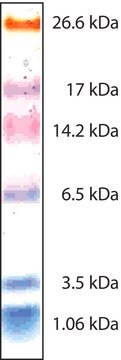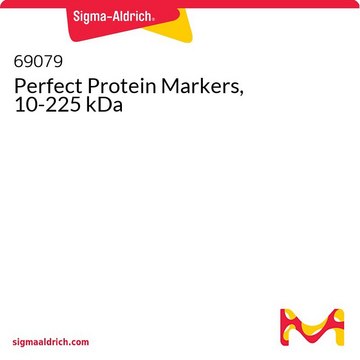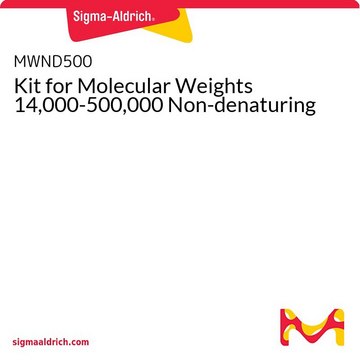M3546
Ultra-low Range Molecular Weight Marker (M.W. 1,060-26,600)
Synonym(s):
protein markers, protein molecular weight markers, protein standards
About This Item
Recommended Products
usage
vial sufficient for 400 applications on large gels (16 × 18 cm)
vial sufficient for 800 mini-gels (10 × 10 cm)
Quality Level
100
200
packaging
vial of 200 μL
storage temp.
−20°C
Application
Biochem/physiol Actions
Physical form
Signal Word
Danger
Hazard Statements
Precautionary Statements
Hazard Classifications
Acute Tox. 4 Dermal - Aquatic Chronic 3 - Eye Dam. 1 - Repr. 2 - Skin Sens. 1
Storage Class Code
10 - Combustible liquids
Flash Point(F)
Not applicable
Flash Point(C)
Not applicable
Regulatory Listings
Regulatory Listings are mainly provided for chemical products. Only limited information can be provided here for non-chemical products. No entry means none of the components are listed. It is the user’s obligation to ensure the safe and legal use of the product.
PDSCL
Please refer to KIT Component information
PRTR
Please refer to KIT Component information
FSL
Please refer to KIT Component information
ISHL Indicated Name
Please refer to KIT Component information
ISHL Notified Names
Please refer to KIT Component information
Cartagena Act
Please refer to KIT Component information
JAN Code
キットコンポーネントの情報を参照してください
Certificates of Analysis (COA)
Search for Certificates of Analysis (COA) by entering the products Lot/Batch Number. Lot and Batch Numbers can be found on a product’s label following the words ‘Lot’ or ‘Batch’.
Already Own This Product?
Find documentation for the products that you have recently purchased in the Document Library.
Customers Also Viewed
Protocols
Separation of Polyacrylic acid (PAA) 438 kDa; Polyacrylic acid (PAA) 235 kDa; Polyethylenimine (PEI) 266 kDa ; Poly(dimethyl diallyl ammonium chloride) (PIDADMACl) 204 kDa; p-Aminosalicylic acid (PAS) 7800 Da; p-Aminosalicylic acid (PAS) 257 kDa; Cationic dextran (11 kDa); Chitosan (13.4 kDa)
Our team of scientists has experience in all areas of research including Life Science, Material Science, Chemical Synthesis, Chromatography, Analytical and many others.
Contact Technical Service











